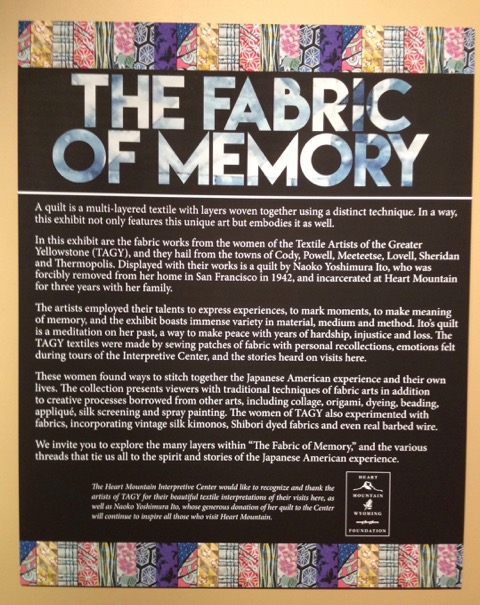The Fabric of Memory
 |
| click to enlarge |
Recently, I went to the Heart Mountain Interpretive Center with some friends. I had been to the museum before, but I really wanted to see the featured quilt show, entitled The Fabric of Memory. The photo above gives an explanation about the show and those involved. Below is a sampling of the small, art quilts in the exhibit.
 |
| Daily Chores Linda MacDonald Powell, WY |
The clothes drying in the breeze are made from actual Japanese kimono scraps."
 |
| Peaceful Internees Carolyn Aichele Lovell, WY |
One of the reasons this project resonates with me is my personal experience with unfair childhood incarceration. As an 8-year old foster child, I was incarcerated behind barbed wire at a juvenile detention facility in Oregon."
 |
| The Children Jeanne Knudsen Cody, WY |
It is heartbreaking to imagine how 'Mother' and 'Father' felt not knowing where they would be sent, what the conditions would be, would the children stay with them or be separated. I imagine there was a lot of worry and concern for all of the family.
Many of the photos at Heart Mountain Interpretive Center are of the children. Although the circumstances were extremely hard for anyone imprisoned illegally, I found that in many of the photos the children were playing baseball, marbles, running and doing schoolwork. I wanted to show that side of the camp in my art. The children of these camps are now grown. Many have had very successful lives. And that, reminds me of a quote: 'Hardships often prepare ordinary people for extraordinary destiny.' CS Lewis"
 |
| Nidoto Nai Yoni "Let It Not Happen Again" Jan Hoar Cody, WY |
I created this quilt with Shibori dyed fabric, photo art and acrylic paint on fabric, yarn and buttons."
 |
| Healing Heart Alice Flyr Cody, WY |
 |
| One Suitcase Carol Kolf Sheridan, WY |
These American citizens with Japanese ancestry were allowed to fill ONE SUITCASE when they were taken from their homes, their jobs, their possessions and their business and brought to an unknown place with meager accommodations."
Note: the quilting on the blue background states, Executive Order 9066.
 |
| Only What You Can Carry Jan Wilbur Cody, WY |
I wonder what they chose to pack without knowing where they were going or how long they would be away from home. Each person was given a tag listing their family name and number. In addition to these, I've added their barrack assignment on the back of each tag on my art quilt.
I think about what I would take. Keepsakes? Extra clothing? Important documents? What would you choose to carry in your bag if you had to leave home for an undetermined place and time?"
* * *
An earlier post about the Heart Mountain Interpretive Center can be seen here.
A beautiful way to tell this tragic story.
ReplyDeleteWhat keepsakes they are.
ReplyDeleteThese beautiful art quilts are an amazing storytelling device. We must never forget this piece of our American story.
ReplyDeleteThose quilts are amazing.
ReplyDeleteOur country proclaims itself to be accepting of all and a compassionate nation --- and yet, history proves time and again this is not alway so.
The first quilt is the one that touches MY heart. In all situations we do what we must do.
I love the CHILDREN and I am An AMERICAN. One suitcase.....how tragic.
ReplyDeleteI'm so glad you shared these photos. I would love to visit the site one day - I've read so much about it. There are things that our nation simply needs to remember. As great the US is - we are not infallible.
ReplyDeleteAmerican History, it may not have been fair but it was a hostile environment perhaps they were safer in the camps than they were out of them:(
ReplyDeleteOne of our best friends was in one of the internment camps as a child. He was fortunate to be able to stay with his whole family and says he has some good memories of those times because his family was able to shelter him to some extent. He is a patriotic American and is not bitter though he has every right to be so. I never want to see that happen to another person in this country! We can't let that happen again!!
ReplyDeleteWow, each one tells it's own story.
ReplyDelete